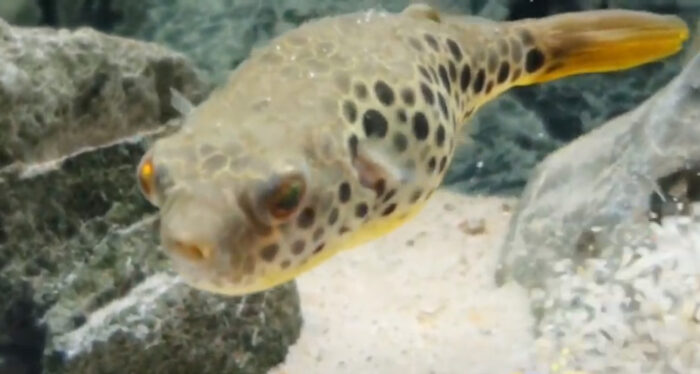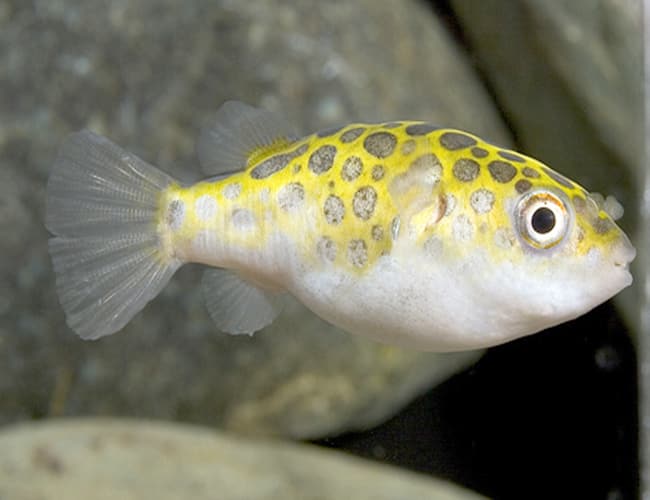Congo Spotted Puffer
If you're looking for an intriguing and unique aquarium fish, the Congo spotted puffer might be just what you need. These fish have a distinctive spotted appearance and are known for being intelligent and active swimmers. But there's more to these fish than just their good looks. Let's dive deeper into the fascinating world of congo spotted puffer.
Pain Points Related to Congo Spotted Puffer
While congo spotted puffers are beloved by many fishkeepers, they are not without their challenges. These fish require specific water parameters and high-quality food to thrive. They are also known to be sensitive to stress and water quality changes, so it's essential to keep their tank environment as stable as possible. Additionally, these fish are not recommended for beginners, as they have unique care requirements and can be challenging to keep healthy and happy.
Answers to Target of Congo Spotted Puffer
Now that we've covered some of the challenges of keeping congo spotted puffers let's dive into what they need to thrive. These fish do best in a tank with plenty of hiding places, such as rock caves or driftwood. Water temperature should be kept between 76-82°F, and pH between 7.5-8.3. It's crucial to keep the nitrate levels low and perform regular water changes to maintain good water quality. As for feeding, congo spotted puffers should be given a varied diet of high-quality frozen or live foods, such as brine shrimp, bloodworms, and krill.
Summary of Main Points Related to Congo Spotted Puffer
In summary, if you're an experienced fishkeeper looking for a unique and fascinating fish to add to your collection, the congo spotted puffer might be an excellent choice. These fish have unique care requirements but can be rewarding to keep if you're willing to put in the work. Remember to provide your puffers with plenty of hiding places, stable water parameters, and high-quality food to keep them healthy and happy.
Personal Experience with Congo Spotted Puffer
One of my favorite fish to keep in my aquarium is the congo spotted puffer. I was immediately drawn to their unique appearance and lively personalities. It took some trial and error to find the right balance of water parameters and feeding habits for my puffers, but once I did, they became a highlight of my collection. Watching them zip around the tank and interact with each other is endlessly fascinating.
 Photo Credit: Maidenhead Aquatics
Photo Credit: Maidenhead Aquatics
Tips for Keeping Congo Spotted Puffer Healthy
When it comes to keeping congo spotted puffers healthy, there are a few key things to keep in mind. Firstly, provide them with a well-planted tank with plenty of hiding places to help them feel secure. Secondly, keep up with regular water changes and monitor nitrate levels to ensure good water quality. Lastly, offer them a varied diet of high-quality live or frozen foods to promote overall health and vitality.
 Photo Credit: Puffer fish, Fish, Aquarium fish
Photo Credit: Puffer fish, Fish, Aquarium fish
Congo Spotted Puffer and Tank Mates
If you're considering adding a congo spotted puffer to your aquarium, it's essential to choose their tank mates carefully. These fish can be aggressive towards smaller or slower-moving fish, so it's best to keep them with other similarly sized and active species. Good tank mate choices for congo spotted puffers include other puffers, larger tetras, or catfish.
 Photo Credit: Helpusfish.com
Photo Credit: Helpusfish.com
Common Health Issues with Congo Spotted Puffer
Like any fish species, the congo spotted puffer can be prone to certain health issues. These include bacterial infections, parasitic infections, and malnutrition. To keep your puffer healthy, it's essential to maintain good water quality, provide a varied and high-quality diet, and monitor for any signs of disease or illness. If you notice any unusual behavior or symptoms, it's best to consult with a fish health professional to identify and treat the problem.
Question and Answer
Q: How big do congo spotted puffers get?
A: Congo spotted puffers can grow up to 4-6 inches in length, making them a mid-sized aquarium fish.
Q: How often should I feed congo spotted puffer?
A: It's best to feed congo spotted puffers small meals two to three times a day to prevent overfeeding and maintain good health.
Q: Can congo spotted puffers live with other fish?
A: Yes, but it's important to choose tank mates carefully and provide plenty of hiding places for all fish to prevent aggression or stress.
Q: Are congo spotted puffers easy to care for?
A: No, congo spotted puffers have specific care requirements and may be challenging for beginner fishkeepers. They require a stable tank environment and high-quality food to thrive.
Conclusion
If you're up for the challenge of keeping a unique and fascinating aquarium fish, the congo spotted puffer might be the perfect addition to your collection. These fish require specific care and attention, but can be rewarding to keep if you're willing to put in the work. Remember to provide plenty of hiding places, monitor water quality, and offer high-quality food to keep your puffers healthy and happy.
Gallery
Spotted Congo Puffer Fish Care : A Complete Guide (With Pictures)

Photo Credit by: bing.com / congo puffer spotted fish around complete care guide oxygenated highly crustacean lurking spend kill ready any water most they find
Spotted Congo Puffer | Puffer Fish, Fish, Aquarium Fish

Photo Credit by: bing.com / fish aquarium puffer spotted congo choose board
Spotted Congo Puffer Or Schoutedeni Puffer | Arizona Aquatic Gardens

Photo Credit by: bing.com / puffer congo fish spotted
*WANTED* Juvenile Spotted Congo Puffer Wanted In Leigh-on-sea, Essex

Photo Credit by: bing.com / congo puffer spotted
Spotted Congo Puffer - Maidenhead Aquatics

Photo Credit by: bing.com / congo puffer spotted tetraodon fish pufferfish freshwater fishkeeper miscellaneous river choose board
